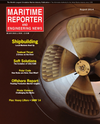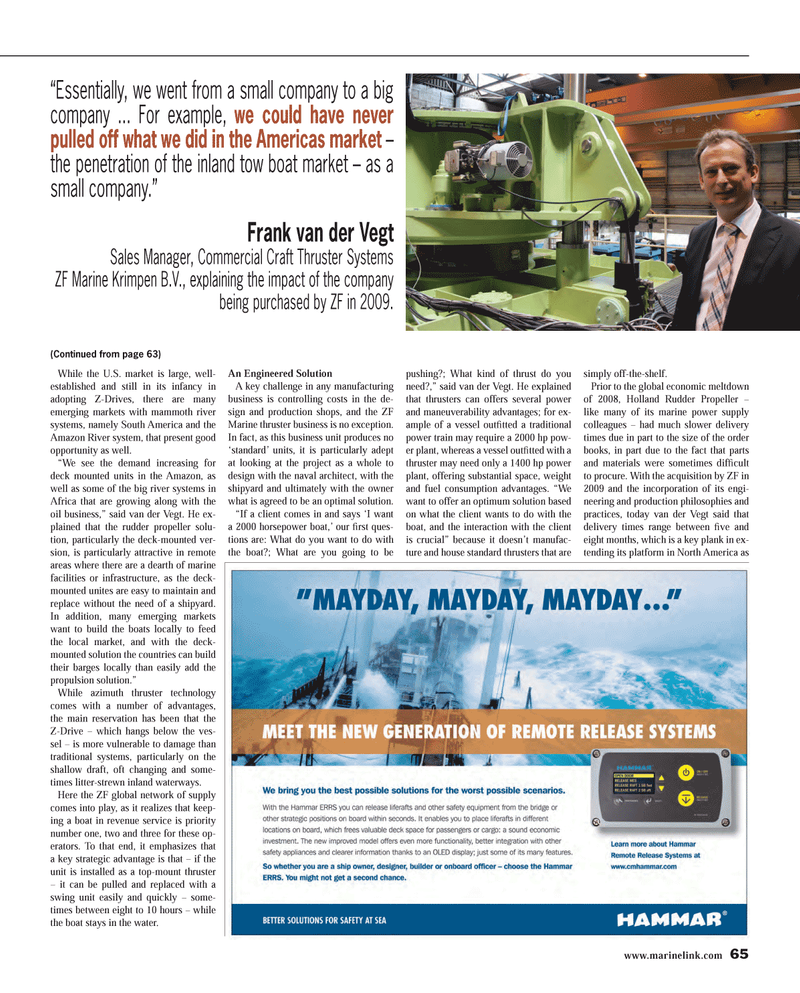
Page 65: of Maritime Reporter Magazine (August 2014)
Shipyard Edition
Read this page in Pdf, Flash or Html5 edition of August 2014 Maritime Reporter Magazine
www.marinelink.com 65While the U.S. market is large, well- established and still in its infancy in adopting Z-Drives, there are many emerging markets with mammoth river systems, namely South America and the Amazon River system, that present good opportunity as well.?We see the demand increasing for deck mounted units in the Amazon, as well as some of the big river systems in Africa that are growing along with the oil business,? said van der Vegt. He ex- plained that the rudder propeller solu-tion, particularly the deck-mounted ver- sion, is particularly attractive in remote areas where there are a dearth of marine facilities or infrastructure, as the deck-mounted unites are easy to maintain and replace without the need of a shipyard. In addition, many emerging markets want to build the boats locally to feed the local market, and with the deck-mounted solution the countries can build their barges locally than easily add the propulsion solution.?While azimuth thruster technology comes with a number of advantages, the main reservation has been that the Z-Drive ? which hangs below the ves-sel ? is more vulnerable to damage than traditional systems, particularly on the shallow draft, oft changing and some-times litter-strewn inland waterways. Here the ZF global network of supply comes into play, as it realizes that keep- ing a boat in revenue service is priority number one, two and three for these op-erators. To that end, it emphasizes that a key strategic advantage is that ? if the unit is installed as a top-mount thruster ? it can be pulled and replaced with a swing unit easily and quickly ? some-times between eight to 10 hours ? while the boat stays in the water. An Engineered Solution A key challenge in any manufacturing business is controlling costs in the de-sign and production shops, and the ZF Marine thruster business is no exception. In fact, as this business unit produces no ?standard? units, it is particularly adept at looking at the project as a whole to design with the naval architect, with the shipyard and ultimately with the owner what is agreed to be an optimal solution.?If a client comes in and says ?I want a 2000 horsepower boat,? our Þ rst ques- tions are: What do you want to do with the boat?; What are you going to be pushing?; What kind of thrust do you need?,? said van der Vegt. He explained that thrusters can offers several power and maneuverability advantages; for ex-ample of a vessel outÞ tted a traditional power train may require a 2000 hp pow-er plant, whereas a vessel outÞ tted with a thruster may need only a 1400 hp power plant, offering substantial space, weight and fuel consumption advantages. ?We want to offer an optimum solution based on what the client wants to do with the boat, and the interaction with the client is crucial? because it doesn?t manufac- ture and house standard thrusters that are simply off-the-shelf. Prior to the global economic meltdown of 2008, Holland Rudder Propeller ? like many of its marine power supply colleagues ? had much slower delivery times due in part to the size of the order books, in part due to the fact that parts and materials were sometimes difÞ cult to procure. With the acquisition by ZF in 2009 and the incorporation of its engi-neering and production philosophies and practices, today van der Vegt said that delivery times range between Þ ve and eight months, which is a key plank in ex-tending its platform in North America as ?Essentially, we went from a small company to a big company ... For example, we could have never pulled off what we did in the Americas market ? the penetration of the inland tow boat market ? as a small company.?Frank van der Vegt Sales Manager, Commercial Craft Thruster Systems ZF Marine Krimpen B.V., explaining the impact of the company being purchased by ZF in 2009. (Continued from page 63) MR #8 (64-73).indd 65MR #8 (64-73).indd 658/7/2014 3:55:42 PM8/7/2014 3:55:42 PM

 64
64

 66
66
